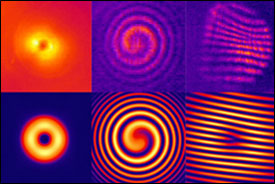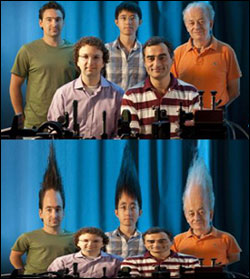
Designer Light Creates Fun-House Mirror Effect
CAMBRIDGE, Mass., Sept. 2, 2011 — While studying the behavior of light on flat surfaces patterned with metallic nanostructures, researchers at the Harvard School of Engineering and Applied Sciences (SEAS) discovered a bizarre phenomenon that defies the laws of reflection and refraction.
For centuries it has been recognized that light travels at different speeds through different media. Reflection and refraction occur whenever light encounters a material at an angle, because one side of the beam is able to race ahead of the other. As a result, the wavefront changes direction.

Nanfang Yu, Zeno Gaburro, Federico Capasso and colleagues at SEAS have created strange optical effects, including corkscrew-like vortex beams, by reflecting light off a flat, nanostructured surface. (Image: Nanfang Yu/SEAS)
Conventional laws in physics predict the angles of reflection and refraction based only on the incident (incoming) angle and the properties of the two media. However, this new discovery dictates that the boundary between the two media, if specially patterned, can itself behave as if it's a third medium.
“Using designer surfaces, we've created the effects of a fun-house mirror on a flat plane,” said Federico Capasso, professor and senior researcher. “Our discovery carries optics into new territory and opens the door to exciting developments in photonics technology.”
The key component is an array of gold nanoantennas etched into the surface of the silicon used in the Harvard SEAS lab. The array is structured on a scale much thinner than the wavelength of the light hitting it. This means that, unlike in a conventional optical system, the engineered boundary between the air and the silicon imparts an abrupt phase shift (dubbed “phase discontinuity”) to the crests of the light wave crossing it.

Top, clockwise from left: Patrice Genevet, Nanfang Yu, Federico Capasso, Zeno Gaburro and Mikhail A. Kats. Bottom: A simulation of the image that would appear in a large mirror patterned with the team's new phase mirror technology. (Image: Grinnell and Nanfang Yu)
Each antenna in the array acts as a tiny resonator that can trap the light, holding its energy for a given amount of time before releasing it. A gradient of different types of nanoscale resonators across the surface of the silicon can effectively bend the light before it even begins to propagate through the new medium.
The resulting phenomenon breaks the old rules, creating beams of light that reflect and refract in arbitrary ways, depending on the surface pattern.
“By incorporating a gradient of phase discontinuities across the interface, the laws of reflection and refraction become designer laws, and a panoply of new phenomena appear,” said Zeno Gaburro, a visiting scholar in Capasso's SEAS group who was co-principal investigator for this work. “The reflected beam can bounce backward instead of forward. You can create negative refraction. There is a new angle of total internal reflection.”
Moreover, the frequency (color), amplitude (brightness), and polarization of the light can also be controlled, meaning that the output is in essence a designer beam.
The study was published in the journal Science.
For more information, visit: www.harvard.edu
Published: September 2011